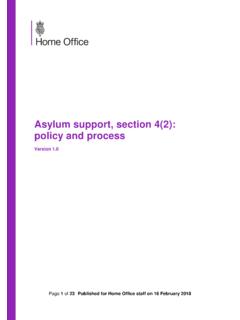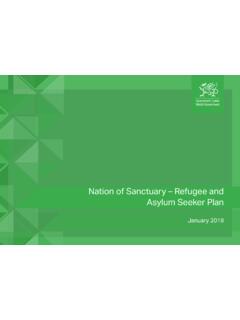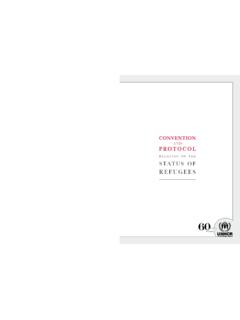Transcription of Temporary Protected Status: Overview and Current Issues
1 Temporary Protected Status: Overview and Current Issues Jill H. Wilson Analyst in immigration Policy January 17, 2018 Congressional Research Service 7-5700 RS20844 Temporary Protected Status: Overview and Current Issues Congressional Research Service Summary When civil unrest, violence, or natural disasters erupt in countries around the world, concerns arise over the ability of foreign nationals in the United States from those countries to safely return. Provisions exist in the immigration and nationality Act (INA) to offer Temporary Protected status (TPS) and other forms of relief from removal under specified circumstances. The Secretary of Homeland Security has the discretion to issue TPS for periods of 6 to 18 months and can extend these periods if conditions leading to TPS designation do not change. Congress has also provided TPS legislatively. A foreign national who is granted TPS receives a registration document and employment authorization for the duration of a given TPS designation.
2 The United States currently provides TPS to approximately 437,000 foreign nationals from 10 countries: El Salvador, Haiti, Honduras, Nepal, Nicaragua, Somalia, South Sudan, Sudan, Syria, and Yemen. TPS for Guinea, Liberia, and Sierra Leone expired in May 2017, but certain Liberians maintain relief under an administrative mechanism known as Deferred Enforced Departure (DED). Since September 2017, the Secretary of Homeland Security has announced plans to terminate TPS for four countries El Salvador, Haiti, Nicaragua, and Sudan and extend TPS for South Sudan. No decision about Honduras was made by the statutory deadline in November 2017, thus automatically extending that country s designation for six months. There is ongoing debate about whether migrants who have been living in the United States for long periods of time with TPS should receive a pathway to legal permanent resident (LPR) status. In addition, Venezuela s political and economic strife have prompted some lawmakers to call for its designation for TPS.
3 Temporary Protected Status: Overview and Current Issues Congressional Research Service Contents Background .. 1 Humanitarian Response .. 1 Temporary Protected Status .. 2 Deferred Enforced Departure .. 3 Historical Patterns of Blanket Relief .. 4 Countries Designated for Temporary Protections .. 4 Central America .. 5 Haiti .. 6 Liberia .. 8 Nepal .. 9 Somalia .. 9 Sudan and South Sudan .. 9 Syria .. 10 Yemen .. 10 State of Residence of TPS Recipients .. 11 Adjustment of Status .. 13 Selected Activity in the 115th Congress .. 13 Figures Figure 1. Individuals with Temporary Protected Status .. 11 Tables Table 1. TPS Beneficiaries by Country of Citizenship .. 5 Table 2. Individuals with Temporary Protected Status by State of Residence .. 12 Contacts Author Contact Information .. 14 Acknowledgments .. 14 Temporary Protected Status: Overview and Current Issues Congressional Research Service 1 Background Federal law provides that all aliens1 must enter the United States pursuant to the immigration and nationality Act (INA).
4 The two major categories of aliens in the INA are (1) immigrants, and (2) nonimmigrants, who are admitted for Temporary reasons ( , students, tourists, Temporary workers, or business travelers). Foreign nationals who lack proper immigration authorization generally fall into three categories: (1) those who are admitted legally and then overstay their nonimmigrant visas, (2) those who enter the country surreptitiously without inspection, and (3) those who are admitted on the basis of fraudulent documents. In all three instances, the aliens are in violation of the INA and subject to removal. Temporary Protected Status (TPS), codified in INA 244,2 provides Temporary lawful status to foreign nationals in the United States from countries experiencing armed conflict, natural disaster, or other extraordinary circumstances that prevent their safe return. This report begins by situating TPS in the context of humanitarian responses to migration.
5 Another form of blanket relief from removal3 Deferred Enforced Departure (DED) is also described, as is the historical use of these relief mechanisms. This report then provides data on the countries currently designated for TPS, including the conditions that have contributed to their designation. Past legislation to provide lawful permanent resident status to certain TPS-designated foreign nationals is also described. The report concludes with examples of activity in the 115th Congress related to TPS. Humanitarian Response As a State Party to the 1967 United Nations Protocol Relating to the Status of Refugees (hereinafter, Protocol),4 the United States agrees to the principle of nonrefoulement, which asserts that a refugee should not be returned to a country where he/she faces serious threats to his/her life or freedom. (This is now considered a rule of customary international law.) Nonrefoulement is embodied in several provisions of immigration law.
6 Most notably, it is reflected in INA provisions requiring the government to withhold the removal of a migrant to a country in which the migrant s life or freedom would be threatened on the basis of race, religion, nationality , membership in a particular social group, or political The legal definition of a refugee in the INA, which is consistent with the Protocol, specifies that a refugee is a person who is unwilling or unable to return to his/her country of nationality or 1 Alien is the term used in law and is defined as anyone who is not a citizen or national of the United States. A national is a person owing permanent allegiance to the United States and includes citizens. Noncitizen nationals are individuals who were born either in American Samoa or on Swains Island to parents who are not citizens of the United States. In this report, the terms migrant, alien, and foreign national are used interchangeably.
7 2 8 1254a. 3 The term blanket relief in this report refers to relief from removal that is administered to a group of individuals based on their ties to a foreign country; this stands in contrast to asylum, which is relief administered on a case-by-case basis to individuals based on their personal circumstances. 4 The 1951 United Nations Convention Relating to the Status of Refugees, which was amended by its 1967 Protocol, defines who is a refugee and sets out the legal, social, and other kinds of protections that refugees and those seeking asylum are entitled to receive. It also states the responsibilities of nations that grant asylum. United Nations High Commission for Refugees, Convention Relating to the Status of Refugees and Its 1967 Protocol, Geneva, Switzerland, 5 Section 208 of INA (8 1158); Section 241(b)(3) of INA (8 1231); and Section 101(a)(42) of INA (8 1101(a)(42)). Temporary Protected Status: Overview and Current Issues Congressional Research Service 2 habitual residence because of persecution or a well-founded fear of persecution on account of race, religion, nationality , membership in a particular social group, or political This definition also applies to individuals seeking asylum.
8 Under the INA, refugees and asylees differ on the physical location of the persons seeking the status. Those who are displaced abroad to a country other than their home country apply for refugee status, while those who are in the United States or at a port of entry apply for Other migrants in the United States who may elicit a humanitarian response do not meet the legal definition for asylum; under certain circumstances these persons may be eligible for relief from removal through TPS or DED. Temporary Protected Status TPS is a blanket form of humanitarian relief. It is the statutory embodiment of safe haven for foreign nationals within the United States who may not meet the legal definition of refugee or asylee but are nonetheless fleeing or reluctant to return to potentially dangerous situations. TPS was established by Congress as part of the immigration Act of 1990 ( 101-649). The statute specifies that the Secretary of the Department of Homeland Security (DHS),8 in consultation with other government agencies (most notably the Department of State), may designate a country for TPS under one or more of the following conditions: ongoing armed conflict in a foreign state that poses a serious threat to personal safety; a foreign state request for TPS because it temporarily cannot handle the return of nationals due to environmental disaster; or extraordinary and Temporary conditions in a foreign state that prevent migrants from safely returning.
9 A state may not be designated for TPS if the Secretary of DHS finds that allowing its migrants to temporarily stay in the United States is against the national The Secretary of DHS can issue TPS for periods of 6 to 18 months and can extend these periods if conditions do not change in the designated To obtain TPS, eligible migrants within the United States must pay specified fees11 and submit an application to Citizenship and immigration Services (USCIS) before the deadline set forth in the Federal Register notice announcing the TPS designation. The application must include supporting documentation as evidence of eligibility ( , a passport issued by the designated country and records showing continuous physical presence in the United States since the date established in the TPS designation).12 The statute specifies grounds of inadmissibility that cannot be waived, including those relating to criminal convictions and the persecution of 6 INA 101(a)(42).
10 7 See CRS Report R41753, Asylum and Credible Fear Issues in immigration Policy; and CRS Report RL31269, Refugee Admissions and Resettlement Policy. 8 When TPS was enacted in 1990, most immigration -related functions, including designating countries for TPS, fell under the authority of the Attorney General. With the creation of the Department of Homeland Security in 2002 ( 107-296), most of the Attorney General s immigration -related authority transferred to the Secretary of DHS as of March 1, 2003. 9 INA 244(b)(1). 10 There is no limit on the number of extensions a country can receive. 11 Fees for initial applicants include a $50 application fee (may not exceed $50 per 9 1254a (c)(1)(B)), an $85 biometrics services fee for those age 14 and over, and a $410 filing fee for employment authorization (if applying for employment authorization and between the ages of 14 and 65). Applicants may request a waiver of the application and biometrics fees per 8 (c).















